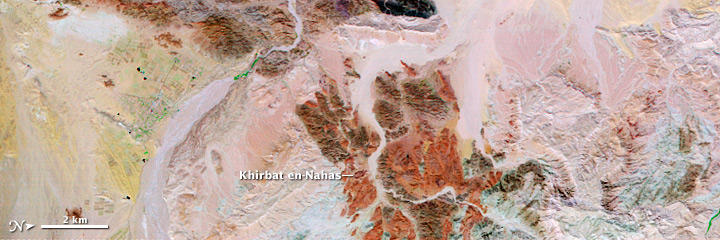

“Hyperion is probably the future of remote sensing,” says Cramer. Hyperion is a hyperspectral instrument, a change in technology that is like going from black-and-white to color television, Mandl adds.
Other remote sensing instruments—multispectrometers—measure discreet wavelengths of light. It is as if your eyes could only see red and blue light; you could tell much about the world based on how much red and how much blue you saw, but your vision would have gaps in the green tones. A hyperspectral instrument corrects this color blindness by measuring many more wavelengths of light.

Multispectral sensors like ALI record discrete wavelengths of light, essentially sampling sections of the electromagnetic spectrum. A hyperspectral instrument like Hyperion records many adjacent wavelengths to image most of the spectrum within a set range. (NASA image by Robert Simmon.)
The science behind the hyperspectral instrument is spectroscopy, says current EO-1 project scientist, Elizabeth Middleton (GSFC). “Spectroscopy is the study of constituents of materials using specific wavelengths,” she notes. “Hyperion measures the chemical constituents of Earth’s surface.”
Chemists have long used spectroscopy to identify substances because everything reflects electromagnetic energy (including light) at specific wavelengths and in ways that are as unique as a fingerprint. By measuring the energy that comes from a material, scientists can figure out what the material is. Hyperion measures reflected light like many other satellite imagers, but since it is recording more than 200 wavelengths, it can detect the fingerprints of the materials on Earth’s surface.

Just as iron and copper look different in visible light, iron- and copper-rich minerals reflect varying amounts of light in the infrared spectrum. This graph compares the reflectance of hematite (an iron ore) with malachite and chrysocolla (copper-rich minerals) from 200 to 3,000 nanometers. (NASA image by Robert Simmon, using data from the USGS Spectroscopy Lab.)
Space-based imaging spectroscopy enables a wide range of science, including the search for those ancient copper mines and smelting sites in Jordan. “I’m looking for the spectrographic signature of copper-bearing minerals,” says Savage. He intended to use copper’s unique light signature to find more smelting sites near Khirbat en-Nahas, but as he started to work with Hyperion data, he realized that it could do much more.
“Hyperion has really opened up a whole new avenue of analysis that we hadn’t even explored before,” says Savage. “I can tell you where in the area the ore is coming from; which parts of the site were used for smelting and which were not; and that different parts of the site were drawing ore from different regions.” Such information would be prohibitively expensive to gather in field research, but Hyperion provides Levy (from the University of California-San Diego) with an affordable map that he can use to better target excavation at likely smelting sites and mines.


The hundreds of bands in hyperspectral imagery enable researchers to differentiate minerals and rocks that appear similar in visible light. Outcrops near Khirbat en-Nahas that are uniformly dark in natural color (top) are variegated in false-color (lower), signifying different rock types. (NASA images by Robert Simmon, using Hyperion data.)
Hyperion data have found a wide range of other uses, including tracking the amount of carbon plants take out of the atmosphere everywhere from the Amazon rainforest to the Alaskan tundra. It also has been used to find evidence of microbial life in the Arctic and to monitor volcanic activity.
Perhaps the most important thing Hyperion has done, says Middleton, is teach the community how to work with complex hyperspectral data. Germany will soon launch the next hyperspectral instrument, EnMap, followed by NASA’s HyspIRI satellite, which is still in the planning stage. Both missions build on lessons learned from Hyperion.